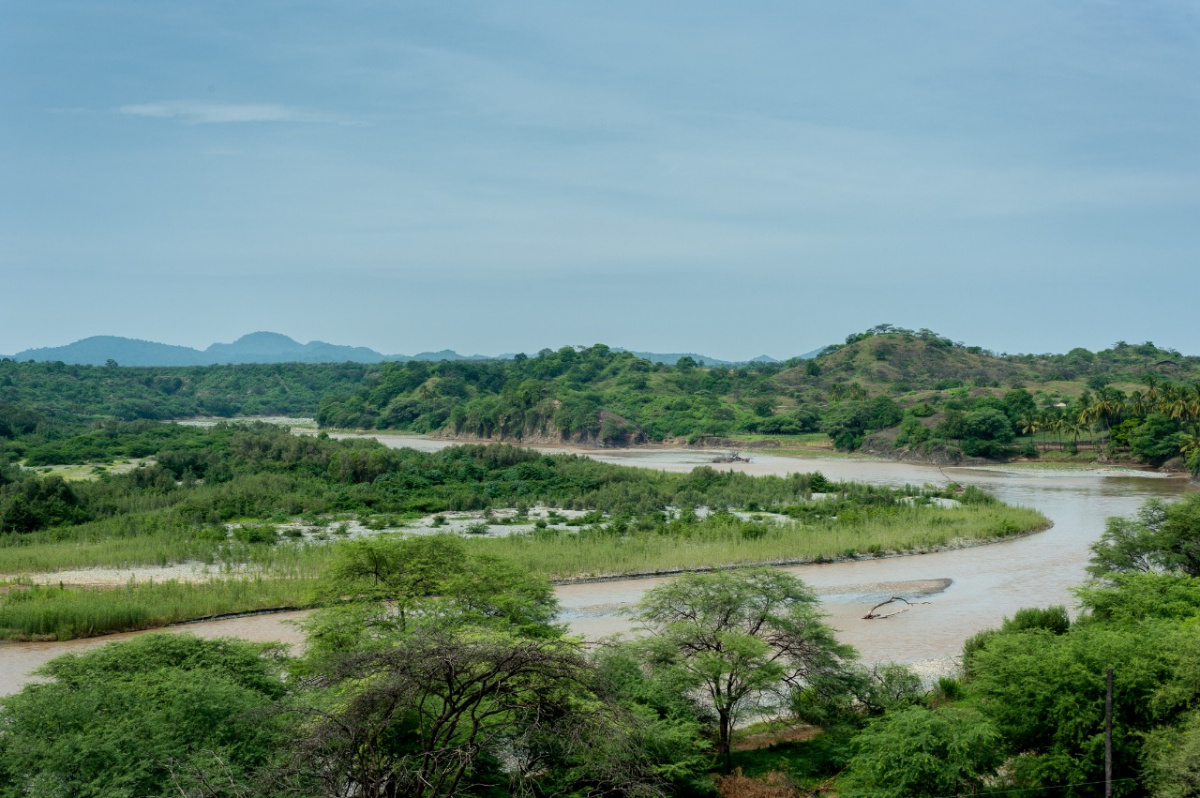IUCN Director General’s statement at Eye On Earth Summit, Abu Dhabi: Creating the enabling environment
Your Royal Highnesses
Your Excellencies
Ladies and Gentlemen
Our planet is at a crossroads. We are looking down two possible and very different futures. The path we choose will determine everything, and humanity will travel along this chosen route for generations and generations to come.

Photo: Yuriy Kulik/Shutterstock
One road continues our current path of unsustainable development. The gap between the world’s rich and poor continues to widen. The spectre of climate disruption looms large on the horizon. New challenges – ocean plastics, systemic pesticides, fungal diseases – are emerging with disturbing regularity. Of particular concern for IUCN – and I know, for Abu Dhabi, our hosts today – is the fact that our actions have resulted in a rate of irreversible species extinction one-thousand times the natural rate.
The other road is one of dramatic change. Change in policy and change in practice. And there are many encouraging signs beckoning us in this direction.
The coming year is perhaps the greatest opportunity we have ever had for setting our planet on a course of sustainable development. The UN has just agreed on the bold 2030 Agenda for Sustainable Development. In Paris this December the world’s governments must reach agreement on how to tackle climate change. We have reached the halfway mark for the 2011–2020 Strategic Plan for Biodiversity and its 20 Aichi Targets. And next year’s IUCN World Conservation Congress will be a crucial milestone in turning these agreements into action.
Data revolution. But to make these commitments realisable we need data, good data. And that means we will need a concerted and sustained data revolution. The Sustainable Development Solutions Network has emphasised exactly this and we will hear more from Jeffrey Sachs himself on this point in a few minutes.
But we are not starting from zero. As we have seen over the last two days here at the Eye on Earth Summit, huge steps forward have been made recently in both clarifying the demand for these data, and in establishing its supply. However, these efforts are not enough. My overall message this morning is that the enabling conditions do not yet exist to match the supply with the demand for environmental data, and therefore prevent informed decision-making.
Specifically, I want to highlight four major themes where substantial effort is necessary to change the playing field to allow truly evidence-based decisions: these are (1) financing, (2) incentives, (3) technology, and (4) capacity.
Examples of current investment shortfall. Allow me to draw from the example of the knowledge products mobilised against IUCN-approved standards: The IUCN Red List of Threatened Species, Red List of Ecosystems, Key Biodiversity Areas, and Protected Planet. There is enormous demand for these knowledge products from policy and practice:
• They were used to derive one-third of the indicators used in the Fourth Global Biodiversity Outlook to track progress towards the Aichi Targets.
• They form the basis of the International Finance Corporation’s Performance Standard 6 on environmental sustainability, and similar mechanisms used throughout the Equator Principles Banks, influencing tens of billions of dollars of investment annually.
• They are widely used by national and local governments, NGOs, and foundations around the world.
What sort of funding maintains such effort? Since 1979, IUCN’s Members, Commissions, Secretariat, and partners have leveraged investments of $160m in the development and maintenance of these knowledge products. This averages out to around $5m annually, about half of it from philanthropic sources, and more than three-quarters of it spent on staff time: warm bodies are necessary to maintain data. This investment has leveraged about 300 years of volunteer time from expert professionals.
We need to double current investment levels. How does this investment compare to real needs? Our projections suggest that an additional $93m of one-off investment will be necessary to reach comprehensive baselines for all four knowledge IUCN products. Once these baselines are reached, the ongoing annual cost of maintaining the four knowledge products will be $13m – or double the level of current investment.
A small investment when all things considered. While this is a large increase compared to current efforts, it is dwarfed by the costs of maintenance of knowledge products in other socio-economic and even environmental domains. For example, the 2010 US Census cost $13bn, the Global Observing System for Climate requires $5-7bn annually, and the US West Coast Earthquake Early Warning system costs $16m per year.
More public and private sector investments are needed. Maintaining these knowledge products is easily affordable, but requires urgent investment if it is to prevent expensive decision-making errors, errors we can ill afford to make. Moreover, while philanthropic finance to date has provided excellent catalysis, the public and private sectors must pick up a much greater share of these investments to ensure that they are mainstreamed into the future, while philanthropic support focuses more and more on implementation on the ground. I am hoping that Enrico Giovannini might have some further insights to share with us here during the upcoming panel discussion.
Open access is key to informed decision-making. The last decade has seen a dynamic shift towards open access in publishing and data availability. I welcome this – making environmental information available is key to informing decisions, influencing actions and delivering sustained environmental improvements. Indeed, it is well documented that open access increases data uptake and, by extension, impact.
However, a word of caution may be required. I would like to add some caveats and cautions which I believe to be important for discussion as we collectively move into the brave new world of open access.
Giving due credit. One caveat regarding open access is the challenge in maintaining attribution and credit to those responsible for knowledge generation. If open access leads to plagiarism and un-attributed redistribution, the incentive for those hard at work collecting data to share is greatly reduced. IUCN’s response to this issue, looking at the specific example of the Red List, has been to begin to establish Digital Object Identifiers for every one of the more than 75,000 species assessments, such that the individual authors of each will have their citation in the permanent, archived record. The dissemination of data through web services, with automatic attribution retained by any secondary users of the data, is also key.
Data aggregators. A second caution relates to the rise of duplicative and even parasitic “data aggregators”, which harvest and redistribute datasets. These unscrupulous systems undermine incentives to maintain data by failing to maintain appropriate attribution and thus jeopardise evidence-based decision-making by serving static versions of data which are rapidly outdated. While such redistribution may be impossible to prevent, the establishment of clear Terms & Conditions of Use are essential to minimise it.
Free vs purchased use. A third question worth posing regarding open access is whether commercial users of environmental data should receive these data freely? Governments and NGOs – our Membership – should have open access to data generated through the Union. However, for those who seek to profit from use of these data, IUCN’s Council “Policy for Commercial Use of IUCN Biodiversity Data” proposes that commercial applications of environmental data should pay to support the maintenance and currency of these data.
Technology has the potential to reshape the enabling conditions in this arena. This has been a theme that has emerged multiple times over the last couple of days, especially regarding technology for remote sensing, given the contributions of our colleagues from the Group on Earth Observations (GEO) and the World Resources Institute (WRI).
Enhancing data utility. My core message here is that, yes, technology has huge potential to increase data volume and breadth, but more importantly, it stands to increase the utility of environmental data by facilitating tool development. I suspect that some of our panellists this morning, such as Carmelle Terborgh from ESRI, a leading technology company, will have important additional perspectives to share on this topic in a few minutes.
Regarding remote sensing, it is evident that efforts to generate environmental data from space have, to date, focused on forests, given the fact that they are relatively easy to monitor, and that they are so important for biodiversity, carbon storage, hydrological function, and indigenous livelihoods. Continuation of this progress is important, but I also see great potential for remote sensing to complement this through the generation of information on other ecosystems - for example, drylands, wetlands, and marine - and also drivers of change such as land use change, invasive species outbreaks, and illegal fishing.
SMART. In addition, such innovation must also be complemented by wiser application of technology in the field. The development over the last few years of the Spatial Monitoring And Reporting Tool, or SMART, allows park and reserve managers to optimise their efforts to help deter wildlife crime, and the major improvements of technologies for tracking the movements of wild animals, are examples where technology has led to major progress in better understanding the natural world. IUCN supported SMART, which has been developed by a number of prominent IUCN Members, along with UNEP, through the Convention on International Trade in Endangered Species, and is being rolled out in numerous countries around the world.
Better tools. Maybe even more importantly, we need to use technology better if we are to help make existing data more useful and useable to decision-making processes. Better tools are often even more important than better data.
IBAT. I would like to highlight the Integrated Biodiversity Assessment Tool, or IBAT, a partnership between BirdLife International - we will hear more from Patricia Zurita, BirdLife’s CEO, in a minute - Conservation International, UNEP’s World Conservation Monitoring Centre, and IUCN, which packages the knowledge products discussed earlier, in ways specifically designed to support the implementation of environmental impact assessments and the screening of potential development projects in advance of the application of standards and safeguards. IBAT is also in the process of developing a modified version of the tool that targets the public rather than the private sector. This will help governments deliver their reporting requirements to the international conventions.
The final enabling condition that I would like to highlight this morning is capacity building. We need to empower people on the ground to gather data and address the biodiversity crisis. We are too easily dazzled by high technology. Even more important than technological innovation, I want to emphasise that environmental data for informed decision-making needs human capacity – boots on the ground!
There are many successful programmes. We will see some examples of fantastic programmes to build presence on the ground, at the “feet in the field” session later today.
I should credit, in particular, the fantastic leadership role which Abu Dhabi has played on this issue, in establishing the Mohamed Bin Zayed Species Conservation Fund as a key mechanism to support conservation professionals around the world. Other great examples, which will also be featured in the session, are the Conservation Leadership Programme, which is maintained by three IUCN Members – BirdLife International, Fauna & Flora International, and the Wildlife Conservation Society; and the Save Our Species programme - operated by IUCN directly.
Keeping people on the ground. Maintaining real people on the ground in real places is important because many environmental issues are opaque to technological sensors: examples include species populations, wildlife harvest and trade, human well-being benefits from conservation, and governance and rights issues.
Inspiring the next generation. Equally important is the critical need to expose the next generation of sustainable development leaders to nature. We need to give these future leaders the opportunity to understand the perspectives and challenges of the half of humanity who live outside of the 21st century world of plastic, steel, glass, and concrete. And we need to give them the opportunity to fall in love with the marvels of our natural world.
So here we stand, today, at the crossroads. The path we choose must be an informed one, and that requires data.
Financing, incentives, technology, and capacity building - these are the ingredients of the data revolution we need to make happen now.
I will now turn over to our eminent panellists to hear their further perspectives on these key issues.
Your Royal Highnesses, Your Excellencies, Ladies and Gentlemen, thank you very much indeed.



